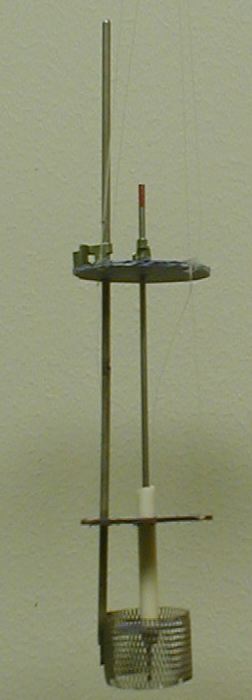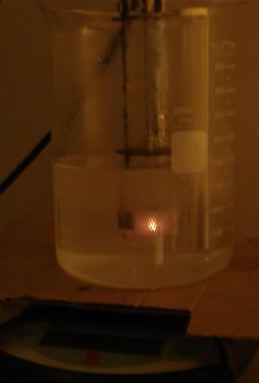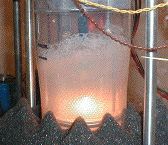
New results and
an ongoing excess heat controversy
VOLTS --> 250 250 300 300 300 355 350 350 400 650 COP --> 1.00 0.99 0.97 1.00 1.00 1.02 1.03 0.98 1.05 1.02The first nine results are based on experiments performed in Texas (2, 3), the 650 volt result is based on experiments performed in Colorado (4). The Colorado setup was similar, in principle, to that used in Texas except for the power supply (see Appendix 1). An important observation concerning both experiments can be seen in Appendix 2. The Colorado experiment was simply a two-liter beaker, mounted on a balance, with two electrodes as shown in Figures 1 and 2.

Figure 1
The cathode (shorter tungsten rod) and the anode (welded to the longer Ti rod), suspended by a nylon thread, are being lowered into the beaker.
Rigidity was assured by two plastic disks (sterilite remains rigid at 100 C). The second function of the lower disk was to act as an antisplashing
baffle, inside the electrolyte.

Figure 2
The cathode and the anode inside the two-liter beaker during a 700 volt test.
Discussion:
Favarque et al report observing COP's up to 1.41 in their experiments. Similar values were observed by other researchers. Clearly we have not
replicated such results. How can this be explained? By experimental errors
(measuring E, Q1 and Q2), or by unrecognized, but significant differences in experimental
setups. Conditions under which experiments were performed might also have been different. Our anodes, for example, were made from platinized niobium
while the anode used in (1) was made from platinized titanium. Instruments used to measure E were also very different. Accurate measurement of the
electrical input power during plasma operation is complicated by the highly erratic current.
In Texas, for example, the average current drawn by the cell was 2-3 amps but the waveform peaks frequently exceeded 10 amps. A sophisticated
Clarke-Hess instrument was able to recognize overloads and signal them by flashing. On a less sophisticated instrument such conditions might be
overlooked and will lead to underestimation of the average power being delivered to the cell. (Overloads were observed during the initial testing;
they were eliminated by placing a large filter capacitor between the Clarke-Hess instrument and the cell, as described in (8).
Possible errors in measuring Q1 and Q2 are discussed in (3).
Let us mention that appearances of the cathode glow discharge in Texas and in Colorado were quite different. In the first case we occasionally
observed white light flashes coming from large regions inside the cell, in the second only a steady yellow light was seen from a small region
surrounding the cathode. Intense white light coming from large regions inside the electrolyte can also be seen on the Internet pictures of similar
experiments performed by other researchers. Another difference worth mentioning was the fact that a typical current (for a given voltage) in Texas
was about four times higher than in Colorado. The plasma differences between the Texas and Colorado experiments were probably due to the arc
suppression abilities of the Colorado power supply (see Appendix 1).
Why is excess heat observed in some recent experimental setups (1, 5, 6, 7) and not in others (8)? Are the discrepancies due to experimental errors
or to unrecognized, but essential ingredients present in some setups and absent in others? It is difficult to answer such questions. Scientific
disputes are not resolved by voting but a large number of confirmations of excess heat, by qualified researchers in many countries, should not be
ignored. The existing controversy would be eliminated if a highly reliable portable excess heat generator could be built. Such generator would then
be studied in different laboratories. How else can a consensus be reached?
Referring to the issue Jed Rothwell (9) wrote: "This is more art than science. Direct, hands-on learning may be the only way to grasp these
things; Mizuno himself does not know what is going on in many ways. Building devices on the basis of described protocols does not seem to be
sufficient." That is a very good point. A tentatively accepted theoretical model would certainly synchronize our dispersive efforts to make
sense out of what is going on in the CMNS field. Trying to confirm or to refute claims made by individual researchers is certainly much less effective
than testing various aspects of a tentatively accepted model.
P.S. (12/2/05, by Ludwik Kowalski):
Unfortunately, one important detail, about the protocol used by Fauvarque et al., was not specified in (8). As I learned from Pierre Clauzon (at the
ICCF12) -- the voltage applied to the cell must change gradually, typically in 20 V increments every minute or so. During that time the cathode was
said to be preconditioned to produce excess heat. Clauzon said that they also failed to confirm reality of excess heat without preconditioning.
P.S. (1/3/06, by Ludwik Kowalski):
In a private message Richard wrote to me that his 30 new attempts to generate excess heat were not successful. He is in contact with Pierre Clauzon.
I hope that the contoversy will eventually be resolved. How can it faile to be resolved when two honest and edicated
researchers are willing to travel and work together, if necessary? I plan to write about this later.
Appendix 1; Pinnacle, a power supply that prevents arcing::
The power supply used in Colorado was a Pinnacle 20kW (10). Although the supply was designed for other purposes it seems to be ideal for GDE (Glow
Discharge Electrolysis) experiments. Its typical applications include dc sputtering with RF bias, basic magnetron sputtering, cathode-arc deposition
(sputter etching and dc-biased RF sputtering). The special features of the Pinnacle are:
1) High line to load efficiency 91%
2) Power factor > 0.9 for loads greater than 1.2kW
3) Quick response to changes in the load
4) Extremely low stored energy in the output filter
5) Fast arc-suppression
8) Ability to preset joules to be delivered to the load
9) Provides up to 20kw of continuous power (we did not exceed 2 kW).
The supply provides very accurate power measurements and the ability to control how the power is delivered to the cell. The Pinnacle can be used as a
source of constant voltage, constant current or constant power, depending on what is chosen. The other two parameters are then determined by the load.
The output voltage, current or power will hold to within +/- 1% as long as the load impedance stays within the voltage and current limits of the unit.
Our tests were performed by using the constant voltage mode, in the voltage range between 400 and 800.
The low stored energy of the output filters of the Pinnacle allows the regulation system of the supply to rapidly respond to changes in the cell
impedance. The low stored energy also prevents the supply from dumping large amounts of energy into the cell as its impedance changes. The low
stored energy is probably one reason that foam, white light and violent reactions, observed in Texas (see Figure 3) were not seen in Colorado.
The other reason was probably the built-in arc suppression.

Figure 3
Foam and white light observed at 350 volts in Texas were not observed at 700 volts in Colorado (see Figure 2).
The pinnacle has several methods of arc suppression. The one we used is called "micro arc suppression." When an arc of less than 10
microseconds occurs, the stored energy is diverted from the cell and the growing arc is extinguished. The voltage is restored, approximately 5
microseconds later. This ability is used in industry to maintain steady even plasma that are required for precise deposition of material on the
manufactured product.
This arc suppression in combination with the low stored output energy of the Pinnacle was most likely the reason that we were able to increase
the potential difference to over 700 volts without the violent reactions in the electrolyte. The arc suppression might also be a reason that our
results are different from those reported in (1). According to (9), Mizuno says "anyone can generate plasma with hundreds of volts. The trick
is to generate it and then gradually reduce input power to the minimum." In one of his papers he writes: "Some researchers have attempted
to replicate the phenomenon, but it has been difficult for them to generate large excess heat. They have tended to increase voltage to a very high
value, around several hundred volts, but they measured no excess heat." Mizuno also indicates that when the cell begins to produce excess heat
the conditions inside the cell are placid. These are the same conditions that we observed in Colorado.
We recognize that the cost of the Pinnacle would make it prohibitive for most experimenters. There are, hpwever, less expensive techniques for arc
suppression that could be added to power supplies. It is likely that arc suppression will help to minimize the power delivered to the cell, at a given
voltage. This might be an important precondition for the generation of excess heat, as indicated by Mizuno.
Appendix 2; On condensation of steam inside cells.
A critical reader might notice that Fauvarque et al.(1) used an open beaker while the cell used in Texas had a lid on top of it. Can this possibly be
a reason for the discrepancy between the outcomes of the experiments? The fraction of steam condensing in a cell with a lid is certainly larger than in
a nearly-open cell. The rate at which the mass is lost is used in the calculation of COP. Therefore, a critical thinker might say, the difference in the
reported values of COP is not surprising. This issue was discussed in (3). The conclusion was that no significant errors are expected from condensation
of water inside the electrolyte, provided the non-evaporative losses are also measured, as in (1). But that was only a logical conclusion based on certain
assumptions. Here is how the conclusion was experimentally validated in Colorado.
a) One liter of water was placed into a two-liter beaker standing on a scale, as in (1). An ohmic heater was used to sustain boiling. The cell had no
lid. The mass lost in 350 seconds was found to be 40.1 grams.
b) The cell was then covered with a plastic plate. That plate had 8 holes (about 1 cm diameter each) plus a hole for the ohmic heater cable. The amount
of water lost in 350 seconds turned out to be 26.1 grams. That confirmed the obvious - condensation is enhanced by covering a cell.
c) A pair of plasma experiments was performed -- one with a nearly open cell and another with a nearly covered cell. The calculated COP turned out to
be 1.00 when the cell was closed (to prevent anticipated splashing that did not materialize) and 1.07 when the cell was essentially open. This pair of
tests, by the way, was conducted at 700 volts. Pairs of tests at 600 and 550 volts also showed that the values of COP are nearly identical and very
close to unity.
Appendix 3; On reporting negative results:
References:
After finishing Colorado experiments, one of us (L.K.) called a friend and talked about the discrepancy between our results and results reported by
other investigators of plasma electrolysis. This prompted him to write the following message:
“I am a retired physics teacher interested in all three CMNS phenomena: CF (cold fusion), CT (cold transmutations), and EE (excess energy). We know that
there are two kinds of experimental results: unreliable and reliable. Unreliable data are obtained when experiments are being set up and when we are not
yet sure that things work properly. Once the initial difficulties are overcome researchers think that results are reliable.
Suppose that reliable experimental data were obtained in ten experiments. Two of these experiments confirmed the expectations and eight did not confirm
them. How should such situation be handled? What should a scientific conference report contain, only two positive results or all results? I know that our
natural tendency is to focus on the most interesting new results. But is this appropriate? I do not think so. Negative results should not be confused with
unreliable results. . . . ”
But the situation is complicated by the fact that some researchers might be hesitant to publish negative results. They might fear that negative statements,
taken out of context, can be quoted by pathological skeptics criticizing the field. In our opinion such fears are not justified; benefits from sharing all
reliable results far outweigh negative consequences of self-imposed secrecy. Unscrupulous critics, such as Dr. Richard Park, should not be feared by honest
researchers. The issue of publishing negative results goes to the heart of scientific methodology. Here is what Ed Storm wrote about publishing negative
results (a private message, 11/19/05): “I would like to throw out some counter thoughts. I think publishing negative results is a waste of time unless
these results reveal a useful pattern. For most phenomena, millions of ways are available that will fail to generate the desired results. In contrast,
many fewer methods will give the desired results. When isolated negative results are reported, they provide no guidance because they are only a few of
so many possible ways to fail. The negative results must be shown to relate to a pattern or a general characteristic. For example in CF, if the H2O
content of the electrolyte is too high, the results will be negative over a wide range of concentration. Unless this fact is related to a positive result
obtained when the H2O content is low, the observations have little value. My point is that people reporting negative results should be required
to show an understanding of their meaning just as people reporting positive results must show what their results mean. However, this does not mean that
negative results can be used to deny the possibility of positive results. The two kinds of results have very little relationship to each other until the
positive results are well understood, because as I said at the start of these comments, many ways exist for a real result to fail.”
We do not agree with this. Negative results are worth sharing and discussing. In this report, for example, one of us (R.L.) speculated that our negative
results might be associated with the absence of arcing (collecting data when arcing was not too intensive in Texas and suppressing arcing electronically
in Clorado). Is it possible that arcing superimposed on the quite glow discharge is an essential component of a device generating excess heat? R.L. plans
to answer this question experimentally in the near future. We think that negative results are worth sharing because, like positive results, they guide
our attempts to understand what is going on.
At one point two of us (R.L. and L.K.) were discussing the magnificent Naudin's report:
P.S.
Subsequently Ed wrote: “You may quote me and even use my name. However, your counter argument to my comment missed the point I was making. As I said,
"I think publishing negative results is a waste of time unless these results reveal a useful pattern." The "useful pattern" is the important aspect of
my comment. In your reply, you showed that your negative results were being used to reveal a useful pattern, i.e. that the nature of arcing was a possible
important variable. . . . During my present study of the F-P effect, I have had many "negative" results. However, I know that certain variables are
important and must be controlled. For example, no excess energy is possible unless the D/Pd ratio in the surface is very high, which is a difficult
condition to achieve. Therefore, I'm investigating the processes that affect this composition. If I report all the negative results without relating
them to the important variables, I would be wasting everyone's time.
1) Fauvarque, J., P. Clauzon, and G. Lalleve, Abnormal excess heat observed during Mizuno-type experiments. 2005, Laboratoire d'Electrochimie
Industrielle, Conservatoire National des Arts et Métiers: Paris.
Available as: <http://www.lenr-canr.org/acrobat/FauvarqueJabnormalex.pdf>
2) See <http://www.earthtech.org/experiments/Inc-W/Fauvarque>
3) See <http://blake.montclair.edu/~kowalskil/cf/267little.html>
4) See <http://blake.montclair.edu/~kowalskil/cf/270slaughter.html>
5) T. Mizuno, D. Chang, F. Sesftel and Y. Aoki “Generation of Heat and Products During Plasma Electrolysis,”. in Eleventh
International Conference on Condensed Matter Nuclear Science. 2004. Marseille, France. Downloadable from the library at
<http://www.lenr-canr.org>
6) D. Cirillo, A. Dattilo, V. Iorio, “Transmutation of metal to low energy in confined plasma in the water (electrochemical plasma
cell),” ,”. in Eleventh International Conference on Condensed Matter Nuclear Science. 2004. Marseille, France. Downloadable
from the library at <http://www.lenr-canr.org>
7) Jean-Louis. Naudin et al. Several illustrations and references are downloadable from <http://jlnlabs.imars.com/cfr/index.htm>. and
from <http://jlnlabs.imars.com/cfr/html/cfrtpwr.htm>
8) Scott R. Little, H. E. Puthoff and Marissa E. Little, “Search for excess heat from Pt electrolyte discharge in
K2CO3-H2O and
K2CO3-D2O electrolysis.” Downloadable
from <http://www.earthtech.org/experiments/Inc-W/Mizuno.html>
9) Jed Rothwell, in an email message, November, 2005.
10) The Advanced Energy Industry, Inc, Fort Collins, Colorado, 80525 80525 <http://www.advanced-energy.com>